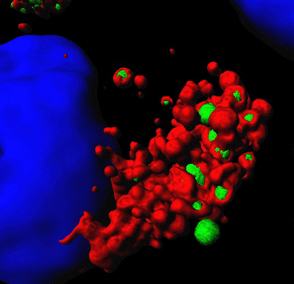

Ingénieur de recherche INSERM,
hakim.ahmed-belkacem@inserm.fr
Over the past few years, the emergence of many viruses (H5N1, SARS, Chikungunya, MERS, Ebola, Zika, etc.) has been making headlines, stressing the vulnerability of humanity in the face of viral risks, as there is no medication to effectively fight against such viral infections. The antivirals currently available (herpes virus, HIV, hepatitis B & C) are almost exclusively directed against their specific target proteins. This selectivity, initially studied to improve tolerance, considerably limits their spectrum of action, making them unsuitable for these new challenges. There is still no treatment for many viral infections of major medical interest.
We are addressing this problem by focusing on the development of broad-spectrum antivirals that can block infection by several unrelated viruses. Such a strategy first requires the identification of a common target involved in the viral cycle of many viruses. Many viruses depend on cyclophilin, a family of 17 human chaperone proteins, making it an ideal target for the developmental of a broad-spectrum antiviral approach.
We have designed the first non-peptidic cyclophilin inhibitors, using fragment-based drug design (FBDD), in collaboration with Professor Jean-François Guichou in Montpellier (University of Montpellier/CNRS/Inserm). These new molecules can inhibit the replication of HCV, Chikungunya virus, several coronaviruses, dengue virus, yellow fever virus, and Zika virus, but are not limited to only these viruses.
This new family of molecules represents a valuable tool for studying the interaction mechanisms of viruses with cyclophilins and the inhibitory mechanisms of cyclophilins against viral cycling. They also show strong potential for industrial development as broad-spectrum antivirals, active against a large variety of viruses belonging to different families.
Cyclophilin inhibitors also have cell-protecting properties associated with the inhibition of mitochondrial transition pore opening, making them potential cell protectors in ischemia/reperfusion (organ transplant, recovery from ischemic heart disease or liver disease, neurodegenerative diseases).

New inhibitors of cyclophilins and uses thereof, 10 nov 2011, WO 2011076784 A3
Fragment-based discovery of a new family of non-peptidic small-molecule cyclophilin inhibitors with potent antiviral activities
Nat Commun. 2016
New pseudodimeric aurones as palm pocket inhibitors of Hepatitis C virus RNA-dependent RNA polymerase
Eur J Med Chem. 2016
Nuclear Envelope Protein SUN2 Promotes Cyclophilin-A-Dependent Steps of HIV Replication
Cell Rep. 2016
Inhibition of RNA binding to hepatitis C virus RNA-dependent RNA polymerase: a new mechanism for antiviral intervention
Nucleic Acids Res. 2014
B-ring modified aurones as promising allosteric inhibitors of hepatitis C virus RNA-dependent RNA polymerase.
Eur J Med Chem. 2014